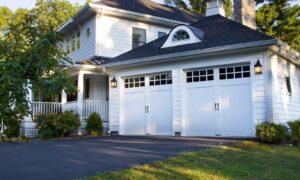The garage door is vital to any residential property, offering security, convenience, and aesthetic appeal. Installing a garage door requires careful planning, knowledge of various types and styles, and adherence to safety protocols. We will walk you through the residential garage door installation process, covering essential steps, materials, and maintenance tips.
Your Comprehensive Guide to Residential Garage Door Installation
- Types of Garage Doors
Several types of garage doors are available at Lewis River Doors in Vancouver, including sectional, roll-up, swing-out, and slide-to-the-side doors. Sectional doors are the most common, with slide-up and overhead panel sections. Roll-up doors, often seen in commercial settings, roll vertically into a coil above the opening. Swing-out doors operate like traditional carriage doors, swinging outward from the center. Slide-to-the-side doors function similarly to sectional doors but slide horizontally along the wall.
- Choosing the Right Door
Selecting the right garage door involves considering material, style, insulation, and automation features. Common materials for garage doors include steel, aluminum, wood, and fiberglass, each offering different levels of durability, aesthetics, and maintenance requirements. Insulated doors are beneficial for energy efficiency and temperature regulation within the garage. Automated features like remote-controlled operation and smart home integration enhance convenience and security.
- Preparing for Installation
Before beginning the installation process, ensure you have the necessary tools and equipment, including a level, drill, screwdriver, measuring tape, and safety gear. Clear the garage space of any obstructions and ensure adequate lighting for working safely. Review the manufacturer’s instructions thoroughly and consult with professionals if needed, especially for complex installations or unique garage designs.
- Installation Steps
- Measurements and Preparation: Accurately measure the garage opening to determine the door size needed. Prepare the door tracks, springs, and hardware according to the manufacturer’s guidelines.
- Installing Door Panels: Assemble the door panels according to the instructions, attaching hinges and rollers as directed. Lift the panels into place and secure them to the tracks.
- Installing Tracks and Springs: Securely install the vertical and horizontal tracks, ensuring they are level and aligned. Attach the springs according to the door type (torsion or extension) and adjust tension as necessary.
- Adding Hardware and Accessories: Install handles, locks, weather stripping, and any additional accessories included with the door. Test the door’s operation manually before connecting any automation components.
- Automation and Safety Features: If installing an automated door, follow the wiring instructions for the opener, sensors, and remote controls. Test the safety features, including auto-reverse mechanisms, to ensure proper functionality.
- Final Adjustments and Testing: Make final adjustments to the door’s alignment, balance, and smooth operation. Test the door multiple times to ensure it opens and closes smoothly without any issues.
- Maintenance and Care
Regular maintenance is essential for prolonging the lifespan and performance of your garage door. Inspect the door and hardware for signs of wear or damage, lubricate moving parts such as rollers and hinges, tighten loose bolts and screws, and test the balance and operation of the door periodically. Keep the tracks clean and debris-free, and address any issues promptly to avoid costly repairs or replacements.
- Safety Considerations
Safety should be a top priority during the garage door installation process. Always wear appropriate safety gear, including gloves and eye protection, when handling tools and equipment. Use caution when working with springs, cables, and other tensioned components, as they can cause severe injuries if mishandled. Follow the manufacturer’s instructions and recommended safety procedures at all times. If you need clarification on any aspect of the installation or encounter unexpected challenges, seek professional assistance to avoid accidents and ensure a safe working environment.
- Environmental Impact and Energy Efficiency
Modern garage doors are designed with energy efficiency in mind, offering insulation options that help regulate temperature and reduce energy consumption. Insulated doors not only keep the garage space comfortable but also contribute to overall energy savings in the home. Consider choosing a garage door with high R-value insulation for maximum efficiency, especially if the garage is attached to the house or used frequently as a workspace. Additionally, eco-friendly materials and sustainable manufacturing practices should be opted for to minimize environmental impact and support green building initiatives.
- Enhancing Curb Appeal and Property Value
Beyond functionality and practicality, a well-chosen garage door can significantly enhance your property’s curb appeal and overall value. Select a door style, color, and finish that complements your home’s architectural style and adds character to the exterior. Customization options such as windows, decorative hardware, and panel designs allow you to create a unique look that sets your home apart. A visually appealing garage door not only impresses visitors but also attracts potential buyers if you decide to sell your home in the future, making it a worthwhile investment in aesthetics and resale value.
Residential garage door installation is a significant investment that adds value, functionality, and curb appeal to your property. By understanding the types of garage doors available, choosing the right door for your needs, following proper installation procedures, budgeting accordingly, and maintaining your door regularly, you can enjoy a secure and efficient garage space for years to come. Consulting with professionals and relying on reputable manufacturers ensures a smooth and successful installation process, providing homeowners peace of mind and convenience.



































